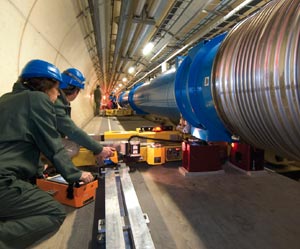On 7 March the first of the superconducting dipole magnets for the Large Hadron Collider (LHC), under construction at CERN, was lowered into the accelerator tunnel.

The 15 m-long dipoles, each weighing 35 t, are the most complex components of the machine. In total, 1232 dipoles will be lowered 50 m below the surface via a special oval shaft. They will then be taken through a transfer tunnel to their final destination in the LHC tunnel, carried by a specially designed vehicle travelling at 3 km per hour.
In addition to the dipole magnets, the LHC will be equipped with hundreds of smaller magnets. More than 1800 magnet assemblies will have to be installed. Once in position, the magnets will be connected to the cryogenic system to form a large string operating with superfluid helium, which will maintain the accelerator at a temperature of 1.9 K.

The lowering of this first magnet into the tunnel coincided with another milestone: the delivery of half of the superconducting dipole magnets. The remaining 616 dipoles are due to arrive by autumn 2006. The construction of these superconducting magnets represents a huge challenge both for CERN and for European industry; for example, some 7000 km of niobium-titanium superconducting cable has had to be produced to form the magnetic cores.
Altogether some 100 companies in Europe are involved in manufacturing the magnet components. The greatest task was the move from the prototyping and pre-series phase to large-scale production. This has been met successfully and three industrial sites, in France, Germany and Italy, are manufacturing about 10 magnets each week.





